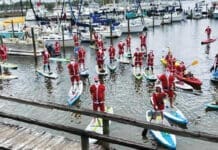Okaloosa County’s Coastal Resource Team with Destin-Fort Walton Beach Tourism recently initiated and assisted a team of researchers in identifying and tagging devil rays in the Gulf of Mexico.
 While installing three miles of sand fencing on Okaloosa Island in 2021, members of the Coastal Resource team noticed a number of devil rays swimming close to the beach. The Coastal Resource Team’s curiosity into the migratory patterns of these rays prompted it to contact researchers from Mote Marine Laboratory & Aquarium in Sarasota.
While installing three miles of sand fencing on Okaloosa Island in 2021, members of the Coastal Resource team noticed a number of devil rays swimming close to the beach. The Coastal Resource Team’s curiosity into the migratory patterns of these rays prompted it to contact researchers from Mote Marine Laboratory & Aquarium in Sarasota.
For 14 years, Mote Researchers have collected data on three pelagic ray species: spotted eagle rays, manta rays and devil rays. All three species are classified as “Endangered.” Understanding the migratory patterns of these rays is important for the conservation of the species.
“Anything we can do to assist in the advancement of an endangered species in Northwest Florida is going to be a benefit for all of us,” said Okaloosa County Board of County Commissioners Chairman Trey Goodwin. “We are lucky to have a team of marine biologists in Okaloosa County’s Tourism Development Department that understands how important these rays are to the collective marine ecosystem.”
 In November, Mote researchers, along with the Okaloosa County Coastal Resource Team, found 17 rays and tagged seven with acoustic tags the size of a small battery. Tracking the movement of the rays will help determine why the rays migrate to the Destin-Fort Walton Beach area in the fall and winter months.
In November, Mote researchers, along with the Okaloosa County Coastal Resource Team, found 17 rays and tagged seven with acoustic tags the size of a small battery. Tracking the movement of the rays will help determine why the rays migrate to the Destin-Fort Walton Beach area in the fall and winter months.
“It will be great to have some answers for the locals and tourists that constantly stop us on the beach asking questions about this very visible species,” said Alex Fogg, Coastal Resource Manager for Destin-Fort Walton Beach. “Hopefully we will see these devil rays returning to our coast year after year and we can determine why they overwinter in our waters.”
This multi-year collaborative study aims to tag 30-50 devil rays. The data will be analyzed to not only provide some insight into the movement ecology of this endangered species but also guide coastal management throughout their range. This is just one of many cooperative projects the Coastal Resource Team engages in with regional universities and scientific partners.






























































